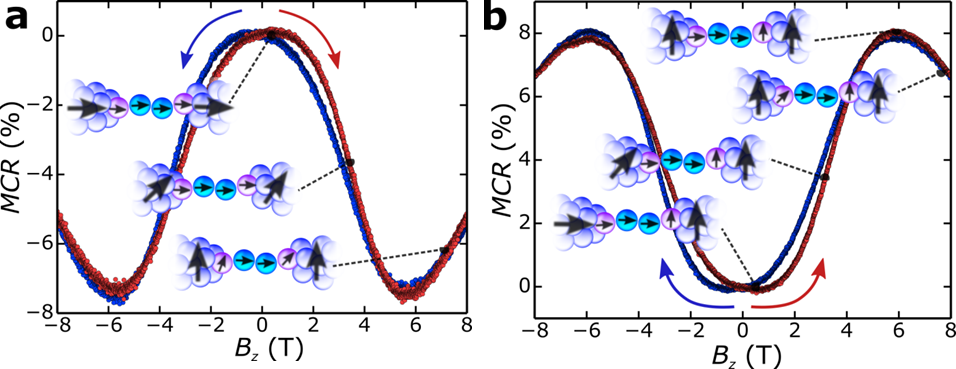
The ongoing downscaling of electronic circuits leads to the question of the ultimate size limit. Naturally, the smallest possible current-carrying structures are molecules or single atoms. The same reason holds for magnetic storage units. While the miniaturization of buildings blocks made out of the band-magnets is limited by the so called superparamagnetic limit, the stability of magnetic order in reduced dimensions might be enhanced for other materials. For the transition metals platinum, palladium and iridium there are predictions of spontaneous magnetic order in atomic size contacts1,2,3.
The aim of this project is to understand the formation of local magnetic order, the magnetic configuration, and possible spin-polarization of conduction channels at the atomic scale by electronic transport measurements. For example we study the magnetic field dependence of the conductance of atomic-size contacts produced via the mechanical controllable break junction method. For all three metals, platinum, palladium, and iridium we found experimental evidence for such local magnetism (Figure 1)4,5,6.
However, different contributions from geometrical structure, spin-orbit-coupling, or spin-dependent scattering could not be discriminated rigorously. Nevertheless, one can conclude that different magnetic ground states are possible in atomic-scale structures of these metals, i.e. a state, where the magnetic moments are aligned non-collinearly (Figure 1b). Currently, we aim at revealing the different contributions to the observed magnetoresistance by studying contacts of rare earths metals (Gd, Tb, Dy). Moreover, we aim at investigating the spin polarization of the current through these contacts as a result of the formation of atomic-scale magnetic order. We follow two complementary approaches to determine the transmission channel configuration and thereby information about the spin polarization. One possibility is to evaluate the signature of (multiple) Andreev reflections in atomic-scale hybrid contacts with superconducting leads7,8. The other possibility is to use the transmission dependent shot noise in ballistic contacts. Here the shot noise should be suppressed for highly spin-polarized currents compared to non-spin-polarized currents9.
(1) A. Delin: Physical Review B 2003, 8, 144434
(2) K. Smeloava: Physical Review B 2008, 77, 033408
(3) A. Delin: Physical Review Letter 2004, 92, 057201
(4) F. Strigl: Nature Communications 2015, 6, 6172
(5) F. Strigl: Physical Review B 2016, 94, 144431
(6) M. Ritter, M. Prestel: under preperation
(7) A. Martín-Rodero: Physica C 2001, 352, 67
(8) M. Andersson: Physica C 2002, 367, 117
(9) A. Burtzlaff: Physical Review Letters 2015, 114, 016602
Publications
- Florian Strigl, Christopher Espy, Maximilian Bückle, Elke Scheer, Torsten Pietsch; Nature Communication 6, 6172 (2015) DOI: 10.1038/ncomms7172
- Florian Stigl, Martin Keller, David Weber, Torsten Pietsch Elke Scheer; Phys Rev B 94 144431 (2016); DOI: 10.1103/PhysRevB.94.144431
Information
Contributors: Martin Prestel, Marcel Strohmeier
Former contributors: Florian Strigl, Christopher Espy, Maximilian Bückle, Markus Ritter
External cooperations: Jason Robinson & Angelo Di Bernardo (Cambridge University)
Fundings: Carl-Zeiss-Stiftung; Leverhulme
Period: since 2013
